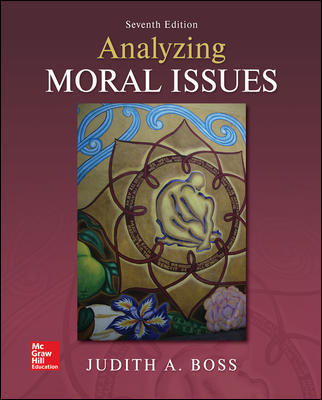This is completed downloadable of Solution Manual for Analyzing Moral Issues 7th by Boss

Product Details:
- ISBN-10 : 0078119200
- ISBN-13 : 978-0078119200
- Author: Judith A. Boss
In Analyzing Moral Issues, the author continues to combine a moral-issues approach to teaching ethics with a solid foundation in moral theory and reasoning. The 7th edition has been updated with new readings and cases pertinent to the issues of today, including income inequality, racism, freedom of speech, and drug and alcohol use. AMI anchors students’ understanding of ethics in a broad perspective of traditions, including virtue ethics (Aristotelian and Confucian, Buddhist and feminist care ethics), deontology, utilitarianism, and Rawlsian ethics. Using primary source material and cases to illustrate these traditions gives students the opportunity to practice making real-life moral decisions.
Table of Content:
- Part 1 Introduction to Moral Philosophy
- Chapter 1 Moral Theory
- Moral Philosophy
- What Is the Purpose of Moral Theories?
- The Types of Moral Theories
- Relativism in Ethics
- Moving Beyond Ethical Relativism
- Morality and Religion
- Universal Moral Theories
- Ethical Egoism
- Utilitarianism
- Deontology: The Ethics of Duty
- Rights-Based Ethics
- Virtue Ethics
- Conclusion
- Aristotle, from Ethics
- Ayn Rand, from The Fountainhead
- Jeremy Bentham, from An Introduction to the Principles of Morals and Legislation
- John Stuart Mill, from Utilitarianism
- Immanuel Kant, from Fundamental Principles of the Metaphysic of Ethics
- Immanuel Kant Translated by Thomas Kingsmill Abbott, from 1785 Fundamental Principles Of The Metaphysic Of Morals
- John Locke, from Two Treatises of Civil Government
- Confucius, from The Analects
- Chapter 2 Abortion
- Background
- The History of Abortion in the United States
- The U.S. Supreme Court Roe v. Wade Decision
- Abortion and Religion
- Methods of Abortion
- The Moral Issues
- Conclusion
- U.S. Supreme Court, Roe v. Wade
- Mary Anne Warren, “The Moral Significance of Birth”
- Don Marquis, “Why Abortion Is Immoral”
- Serrin M. Foster, “Refuse to Choose: Women Deserve Better Than Abortion”
- Linda Lowen, “20 Arguments from Both Sides of the Abortion Debate”
- James Q. Wilson, “On Abortion”
- Case Studies
- Part II Analyzing Moral Issues
- Chapter 3 Euthanasia
- What Is Euthanasia?
- The Philosophers on Euthanasia
- The Contemporary Debate over Euthanasia
- Euthanasia Legislation
- Physician-Assisted Suicide
- The Hospice Movement
- The Moral Issues
- Conclusion
- Margaret Pabst Battin, “The Case for Euthanasia”
- Oregon Health Division, “A Year of Dignified Death”
- Brad Wenstrup, “Resolution Before the United States House of Representatives Opposing Assisted Suicide (H. CON. RES. 80)”
- John B. Kelly, “Why Assisted Suicide Laws Are More Dangerous Than People Acknowledge”
- Ryan T. Anderson, “Commentary on Physician-Assisted Suicide”
- Aaron Rothstein, “All Death Is Death Without Dignity”
- Case Studies
- Chapter 4 The Death Penalty
- History of the Death Penalty
- The Death Penalty Today
- The Death Penalty: Juvenile and Mentally Retarded Offenders
- The Medicalization of Executions
- DNA Testing
- The Philosophers on the Death Penalty
- The Moral Issues
- Conclusion
- U.S. Supreme Court, Gregg v. Georgia (1976)
- Hugo Adam Bedau, “Capital Punishment”
- Helen Prejean, “Would Jesus Pull the Switch?”
- David B. Muhlhausen, “How the Death Penalty Saves Lives”
- Matthew Schmitz, “The Death Penalty Is Just and Merciful”
- Case Studies
- Chapter 5 Drug and Alcohol Use
- What Is a Drug?
- The History of Drug and Alcohol Use
- Legal and Illegal Drugs
- Drug and Alcohol Use Today
- Drug and Alcohol Use Among College Students
- Drugs in Sports
- The Disease Model of Addiction
- The Moral Model of Addiction
- The Philosophers on Drug and Alcohol Abuse
- The Moral Issues
- Conclusion
- Thomas Szasz, “The Ethics of Addiction”
- James Q. Wilson, “Against the Legalization of Drugs”
- Lynn Scarlett, “On the Legalization of Drugs”
- Jeff Berg, “The Logic of Drug Legalization”
- Donald J. Trump, “Speech on the Opioid Crisis”
- Case Studies
- Chapter 6 Feminism, Motherhood, and the Workplace
- Feminism
- The Philosophers on Women
- Motherhood
- Women in the Workplace
- Sexual Harassment
- The Moral Issues
- Conclusion
- Ruth Groenhout, “Essentialist Challenges to Liberal Feminism”
- Linda Hirshman, “Homeward Bound”
- Kelly Oliver, “Fifty Shades of Consent: Rape Culture Versus Feminism”
- Anita Hill, “Opening Statement: Sexual Harassment Hearing Concerning Judge Clarence Thomas”
- Jonathan Andersen, “The Feminine Antidote: Reflections on Masculinity, Patriarchy, and Feminism”
- Case Studies
- Chapter 7 Freedom of Speech
- What Is “Freedom of Speech”?
- Limitations on Freedom of Speech
- The First Amendment to the U.S. Constitution
- Freedom of Speech in Cyberspace
- Pornography
- Hate Speech as Protected Speech
- Speech Codes and Free Speech Zones on College Campuses
- The Philosophers on Freedom of Speech
- The Moral Issues
- Conclusion
- John Stuart Mill, from On Liberty
- Charles R. Lawrence III, “If He Hollers Let Him Go: Regulating Racist Speech on Campus”
- Stanley Fish, “There’s No Such Thing as Free Speech, and It’s a Good Thing, Too”
- Alan M. Dershowitz, “Political Correctness, Speech Codes, and Diversity”
- Jonathan Marks, “Embarrassing Persistence of Campus Speech”
- Traci Yoder, “Free Speech on Campus: A Critical Analysis”
- Case Studies
- Chapter 8 Racism, Economic Inequality, and Global Justice
- Defining the Key Terms
- The Philosophers on Racism
- The Roots of American Racism
- Racism Today
- Globalization, Immigration, and Racism
- The Moral Issues
- Conclusion
- U.S. Supreme Court, Plessy v. Ferguson (1896)
- Lyndon B. Johnson, “To Fulfill These Rights”
- Bernard R. Boxill, “The Color-Blind Principle”
- Senator Patrick Leahy, “S. Res. 56: A Resolution That the United States Should Remain a Global Leader in Welcoming and Providing Refuge to Refugees and Asylum Seekers”
- Stephen Cox, “The Fallacy of Open Immigration”
- Joel Newman, “My Favorite Three Arguments for Open Borders”
- Case Studies
- Chapter 9 War, Weapons, and Terrorism
- Background
- The Philosophers on War and Terrorism
- The Just-War Tradition
- Weapons of Mass Destruction
- Pacifism and Conscription
- The Moral Issues
- Conclusion
- Jonathan Granoff, “Nuclear Weapons, Ethics, Morals, and Law”
- David Luban, “The War on Terrorism and the End of Human Rights”
- Brian Michael Jenkins, “Should Our Arsenal Against Terrorism Include Assassination?”
- Barack Obama, Remarks President Obama on Common-Sense Gun Safety Reform
- Ron Paul, “Conscription—The Terrible Price of War”
- Case Studies
- Chapter 10 Animal Rights and Environmental Ethics
- The Legal and Moral Status of Nonhuman Animals
- The Legal and Moral Status of the Environment
- The Philosophers on the Moral Value of Nonhuman Animals and the Environment
- Animal Farming, Environmental Degradation, and Vegetarianism
- Global Warming and Climate Change
- Animal Experimentation
- The Moral Issues
- Conclusion
- Peter Singer, from Animal Liberation
- Carl Cohen, “Do Animals Have Rights?”
- James Garvey, “Climate Change and Moral Outrage”
- Al Gore, “Testimony before U.S. House of Representatives on Global Warming and the Climate Crisis”
- Case Studies
- Glossary
- Index





